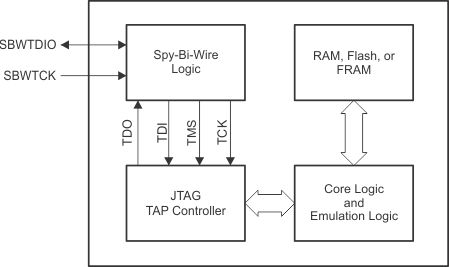SLAU320AJ July 2010 – May 2021
- Trademarks
- 1Introduction
-
2Programming Using the JTAG Interface
- 2.1 Introduction
- 2.2
Interface and Instructions
- 2.2.1 JTAG Interface Signals
- 2.2.2 JTAG Access Macros
- 2.2.3 Spy-Bi-Wire (SBW) Timing and Control
- 2.2.4 JTAG Communication Instructions
- 2.3
Memory Programming Control Sequences
- 2.3.1 Start-Up
- 2.3.2 General Device (CPU) Control Functions
- 2.3.3 Accessing Non-Flash Memory Locations With JTAG
- 2.3.4 Programming the Flash Memory (Using the Onboard Flash Controller)
- 2.3.5 Erasing the Flash Memory (Using the Onboard Flash Controller)
- 2.3.6 Reading From Flash Memory
- 2.3.7 Verifying the Target Memory
- 2.3.8 FRAM Memory Technology
- 2.4
JTAG Access Protection
- 2.4.1 Burning the JTAG Fuse - Function Reference for 1xx, 2xx, 4xx Families
- 2.4.2 Programming the JTAG Lock Key - Function Reference for 5xx, 6xx, and FRxx Families
- 2.4.3 Testing for a Successfully Protected Device
- 2.4.4 Unlocking an FRAM Device in Protected and Secured Modes
- 2.4.5 Memory Protection Unit Handling
- 2.4.6 Intellectual Property Encapsulation (IPE)
- 2.4.7 FRAM Write Protection
- 2.5 JTAG Function Prototypes
- 2.6 JTAG Features Across Device Families
- 2.7 References
- 3JTAG Programming Hardware and Software Implementation
- 4Errata and Revision Information
- 5Revision History
2.2.1.3 2-Wire Spy-Bi-Wire (SBW) JTAG Interface
The core JTAG logic integrated into devices that support 2-wire mode is identical to 4-wire-only devices. The fundamental difference is that 2-wire devices implement additional logic that is used to convert the 2-wire communication into the standard 4-wire communication internally. In this way, the existing JTAG emulation methodology of the MSP430 can be fully used.
 Figure 2-2 Spy-Bi-Wire Basic Concept
Figure 2-2 Spy-Bi-Wire Basic ConceptThe 2-wire interface is made up of the SBWTCK (Spy-Bi-Wire test clock) and SBWTDIO (Spy-Bi-Wire test data input/output) pins. The SBWTCK signal is the clock signal and is a dedicated pin. In normal operation, this pin is internally pulled to ground. The SBWTDIO signal represents the data and is a bidirectional connection. To reduce the overhead of the 2-wire interface, the SBWTDIO line is shared with the RST/NMI pin of the device.
Section 2.6 describes the MSP430 devices and their respective JTAG interface implementation.